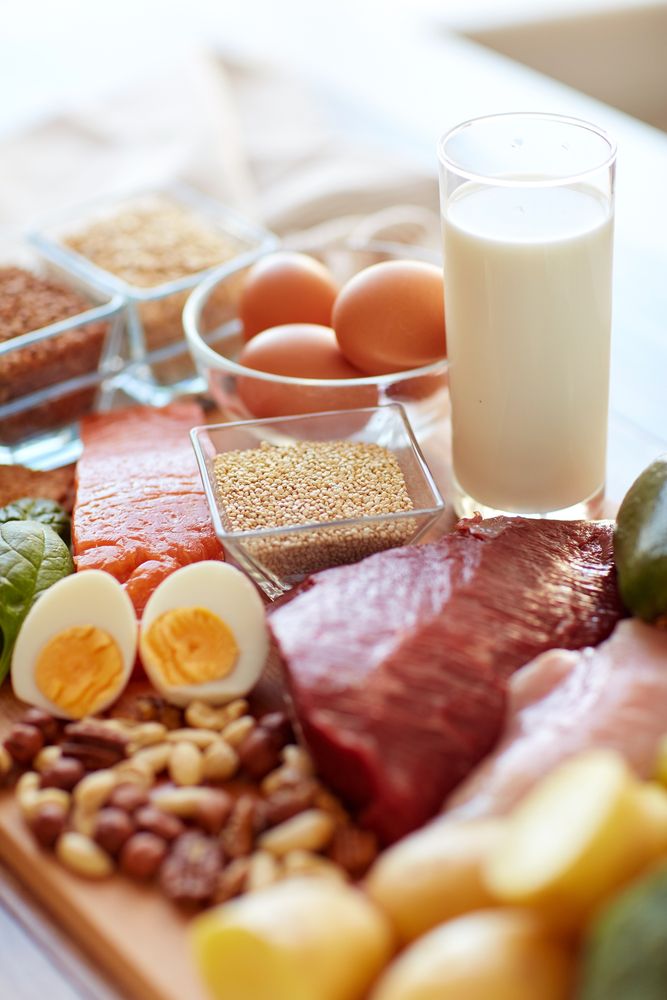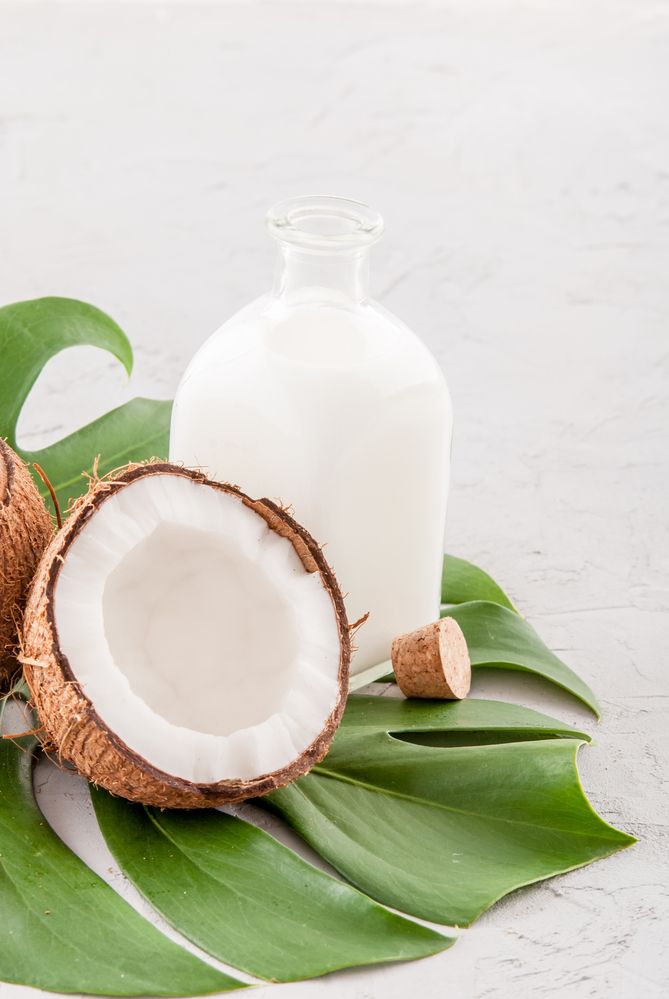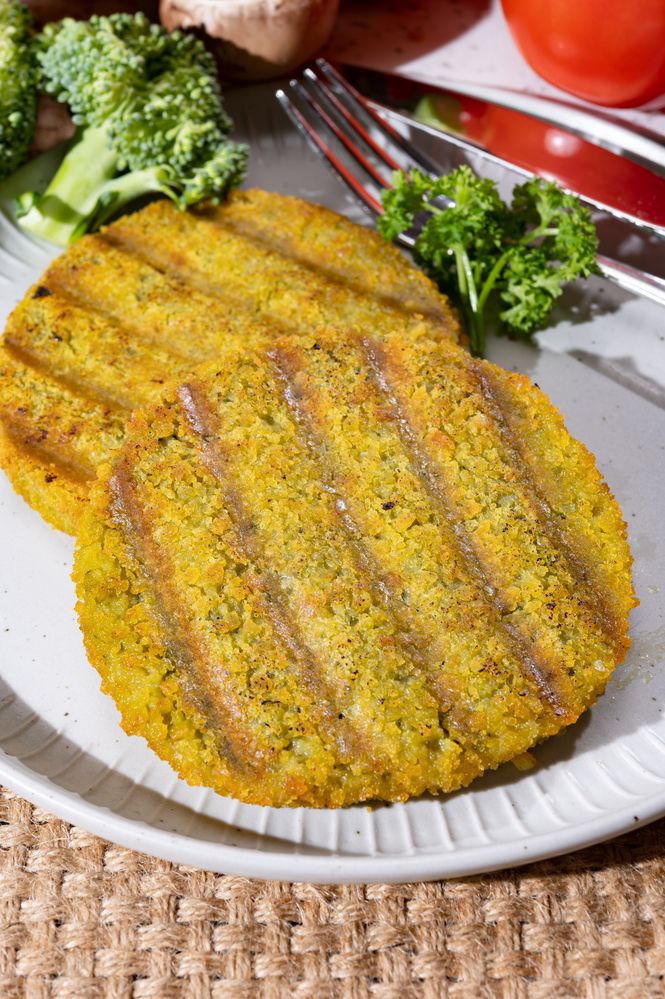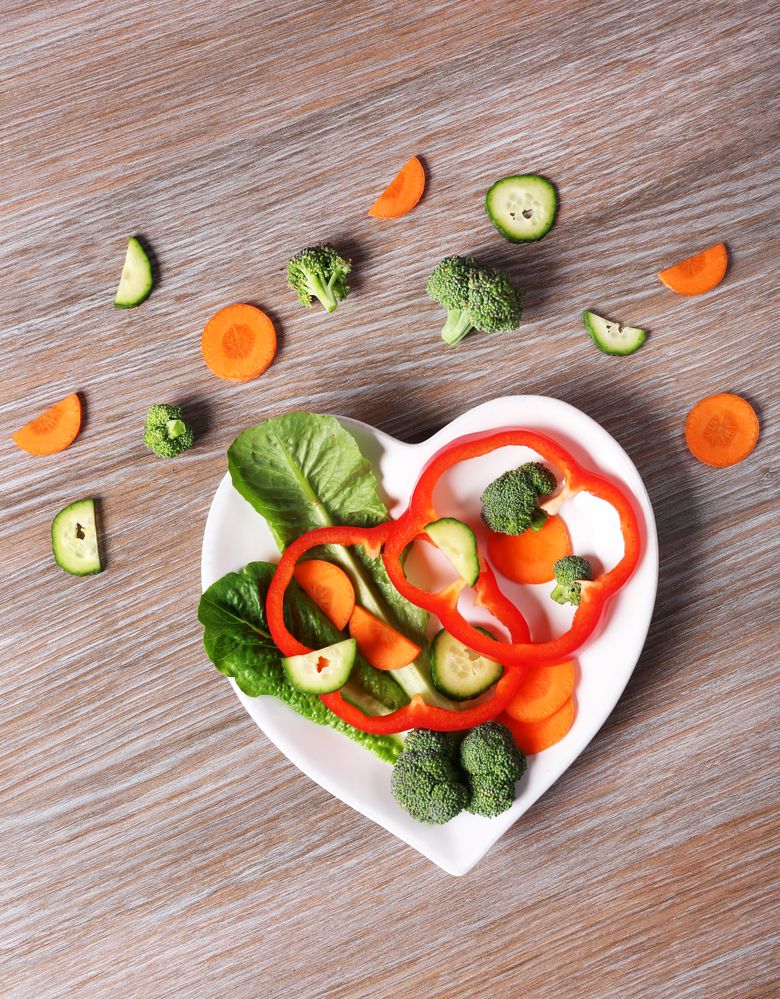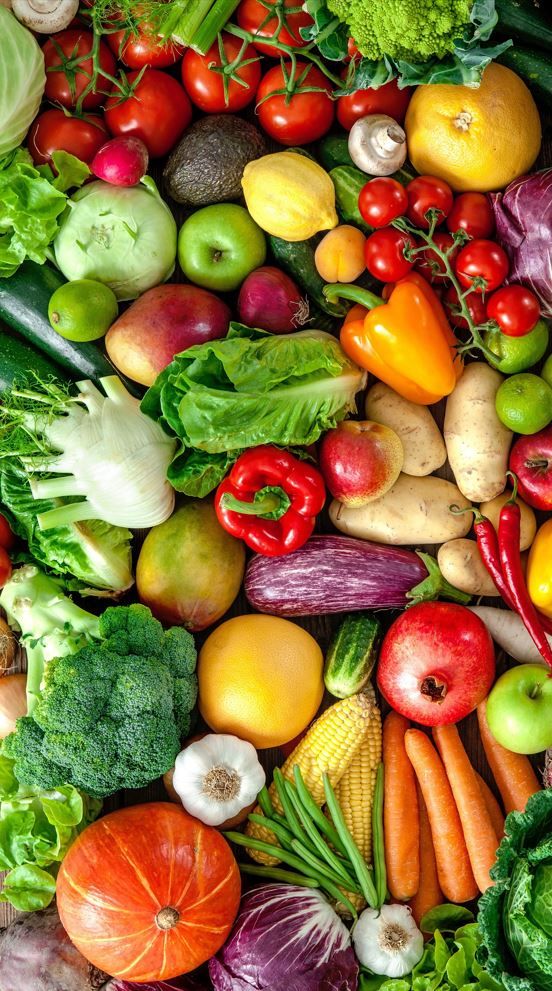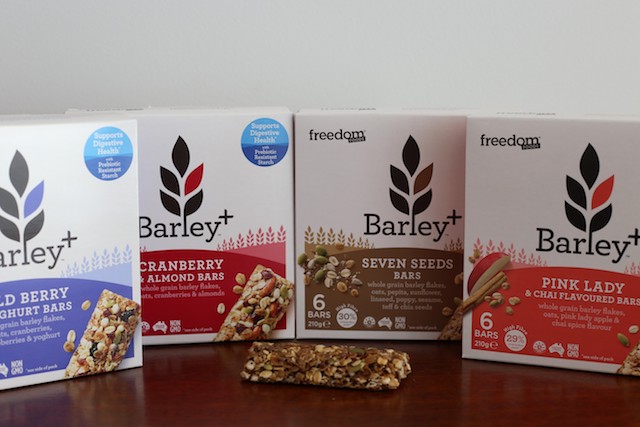Product Review: New Barley+ products
Written by Catherine Saxelby
on Wednesday, 28 February 2018.
Tagged: barleymax, fibre, health, healthy eating, healthy heart, healthy lifestyle, nutrition, resistant starch, review, whole grain

Back in 2009 I wrote about cereals made with the new BarleyMax grain. Then they were tough and often looked over-baked or dark-brown in colour. Since then, they’ve come a long way and are now made by Freedom Foods so I was asked to take another look at them. Here’s what I found.
 This post has been sponsored by Barley+ and Freedom Foods.
This post has been sponsored by Barley+ and Freedom Foods.
Barley+ vs BarleyMax?
I got confused by these similar-sounding terms so it’s worth taking a moment to clarify. Barley+ is the range of products that contain BarleyMax and is the range I’m reviewing here. BarleyMax is the grain. It is a non-GM cultivar (strain) of barley developed by CSIRO scientists in the late 1990s. They were looking for a type of barley with a higher fibre content and extra nutrition benefits. After a number of human trials, they reported that their BarleyMax had a low Glycaemic Index (GI), meaning it was digested and absorbed slowly, the opposite of most refined carbs like potatoes and white bread.
BarleyMax is a wholegrain that delivers the three important types of fibre – soluble, insoluble and resistant starch. In fact, BarleyMax has the highest fibre content of any whole grain – even oats, rye and wheat - thanks to its resistant starch.
You can read about resistant starch on the website here.
The resistant starch in BarleyMax does four things. It:
- has a mild laxative effect which can increase the bulk of the stool (like insoluble fibre).
- supplies fuel for the friendly bacteria in the bowel which encourages their growth so they can reproduce and outnumber or ‘dominate’ the bad bacteria to keep you healthy.
- produces compounds called short-chain fatty acids (in particular butyrate) which is good for your bowel.
- maintains steady blood glucose levels by increasing the body’s sensitivity to insulin.
Best of all, nutritionists recommend barley for better gut health which means it’s good for your digestion and your overall health.
What Barley+ products are out there?
You’ll be able to spot three types of products, located in the health food aisle of Coles supermarket (at the time of publication):
- Mueslis – two flavours
- Porridge
- Bars – four flavours
Our panel of tasters chomped their way through bowls and bowls plus bars and bars during the course of this Review. Let’s look at each of them in turn.
1. Barley+ Mueslis
You’ll find two flavours of muesli:
- Cranberry and Nuts
- Pink Lady and Macadamia
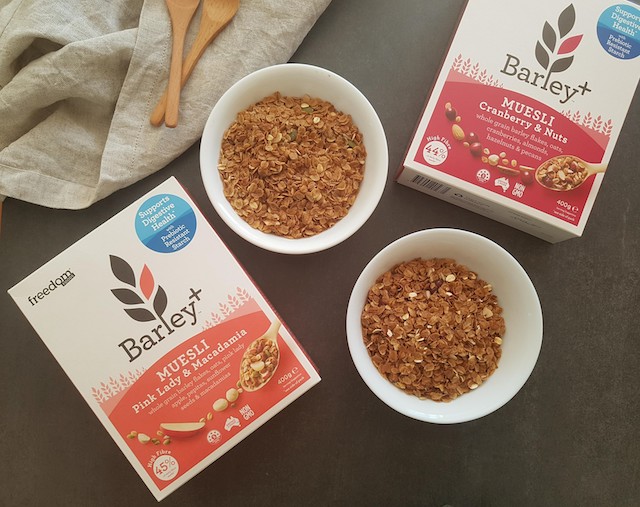
- Both these mueslis were pleasant to eat but our panel’s favourite was the Pink Lady as it was slightly sweeter and more interesting to eat. The panel rated it 3 out of 5 for flavour but only a 2 out of 5 for texture, as it had a slightly ‘crisper’ feel in the mouth. Our panel thought it could do with more fruit and nuts so, if this is you, best to add more of your own.
- They all felt the muesli would work better mixed half-and-half with another cereal like a plainer muesli or into a bowl of lighter flakes or puffs.
- One 50 g serve of the Pink Lady muesli provides a huge 13 grams of dietary fibre, which is almost half or 45 per cent of your day’s suggested intake – wow!
- This fibre is made up of 7.2 g insoluble fibre plus 5.5 g soluble (of which 2.3 g is beta-glucan) plus 0.8 g of the resistant starch
- It has a GI of 40 which is pretty low (legumes are down in the 30s).
- It gives you around 2 serves of whole grains – important as most of us don’t get enough whole grain foods.
- At only 10 mg a serve, there’s hardly any sodium (salt) which is good.
Ingredient List for Pink Lady variety:
| BarleyMax 73%, whole grain rolled oats 9%, pink lady apple 5% (food acid (ascorbic acid)), macadamias 3.5%, coconut sugar, canola oil, sultanas, pepitas 2%, sunflower seeds 2%, natural apple flavour, antioxidant (vitamin E). |
2. Barley+ Porridge
Porridge is hearty and warming once the weather turns cold and this type of porridge won’t disappoint. It’s a mix of 51 per cent BarleyMax and 49 per cent rolled oats. It cooks up on the stove top just like a traditional oaty porridge but of course has those extra BarleyMax health benefits.
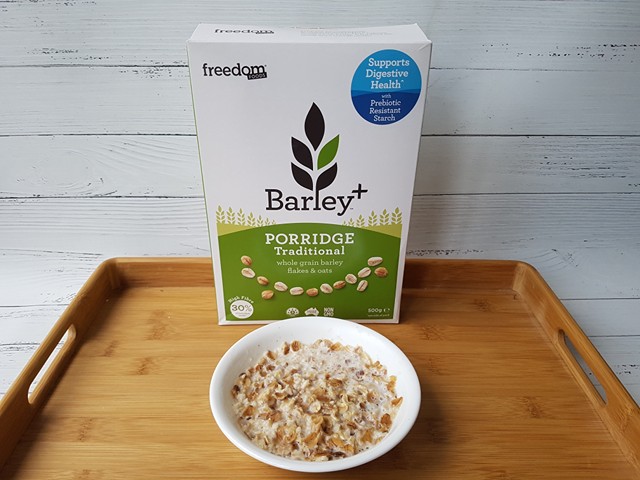
You can also soak it overnight and then microwave a single serve when you’re rushed in the mornings.
3. Barley+ Bars
We taste-tested the 4 varieties of bars –
- Cranberry and Almond
- Pink Lady & Chai Flavoured
- Wild berry & Yoghurt
- Seven Seeds (which has no fruit at all)
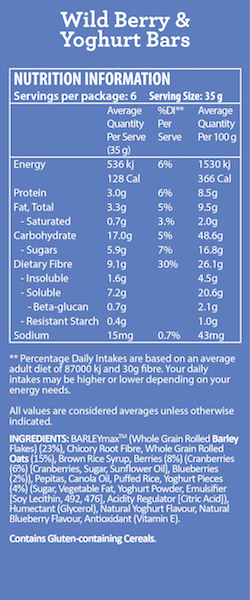 All weigh a satisfying 35 grams (not too big, not too small) and come in a pack containing six bars.
All weigh a satisfying 35 grams (not too big, not too small) and come in a pack containing six bars. - All are similar in appearance, having a glossy finish to their surface. The flavours are different and interesting. They are not too sweet which is good, with the Pink Lady ranked the sweetest and the Seven Seeds the least as expected.
- Our tasters preferred the Wild Berry one followed by the Pink Lady for their taste, appearance and level of sweetness.
- Using the Wild Berry bar as an example, one 35g bar supplies 536kJ (128 Cals), 3 g protein, 3.3 g fat including 0.7 g sat fat, 17 g carb include 5.9 g sugars, a huge 9 g fibre and only 15 mg sodium. Pretty impressive. See label image.
- And good to know that the Seven Seeds variant won the Best Packaged Snack award in 2017 by the Healthy Food Guide magazine.
- All bars had less than 600 kJ which is the official cut-off count for a sensible snack.
- Like all bars, these Barley+ bars are convenient and easy to throw into a handbag, laptop bag or gym bag. They are individually wrapped, so portioned out to prevent overeating.
List of ingredients for Wild Berry andYoghurt Bar:
| BarleyMax (whole grain rolled barley flakes 23%), chicory root fibre, whole grain rolled oats (15%), brown rice syrup, berries 8%, (cranberries 6%, blueberries 2%), pepitas, canola oil, puffed rice, yoghurt pieces 4%, humectant (glycerol), natural yoghurt flavour, natural blueberry flavour, antioxidant (vitamin E). |
Allergens?
These products contain gluten, as all barley foods do, so would not be suitable for those with coeliac disease.
Who would these products be suitable for?
Anyone who doesn’t have a lot of time but wants better health and convenience
I like that Freedom Foods has developed an easy 28-day Gut Reboot Plan to help you feel good. All you have to do is eat 1 serve (1/2 cup) of the muesli every day (or every second day if you think it’s too much at the beginning). Plus one Barley+Bar at some point in the day as well as do some light exercise and eat an otherwise-healthy diet.
They warn you that during the first few days, you might feel a little extra gas in your gut which is a good thing! Despite being conditioned to think of ‘wind’ as bad, a little gas is an easy indication that the bugs are getting stronger and fighting back. It’s something to be pleased about!
However, they caution you to introduce the barley fibre slowly at first. Just start with a little, say 1/3 cup of the muesli for 1 to 3 days, until your body gets used to it. That BarleyMax ingredient can cause tummy bloating, pain and wind if you’re not used to it.
The final word
These are great products to introduce into your daily diet and they add diversity – I love them as they add another grain that’s not wheat. With their special ingredients, they offer a hefty dose of fibre, as well as protein, B vitamins, phosphorus and other minerals, Plus you’ll be boosting your whole grain intake. All good reasons to look out for them in the supermarket aisles.
Thanks to our tasters Dave, Annie, Munaiba and Lesley.
Thanks to dietitian Sophie Feng for the photographs of the product.
Reviews
-
Read more
Product review: Low-sugar alcoholic ginger beer
1 March 2023 by, Catherine Saxelby
Want something to drink before dinner? Something that’s LOWER in alcohol than wine? To match his beer? Then look no further than Bundaberg’s low-sugar alcoholic ginger beer.
You can drink Bundaberg low-sugar ginger beer straight from the can, or pour it into a long glass over ice with a slice of lime.
-
Product snapshot: Berkelo’s Khorasan Macaroni
14 September 2022 by, Catherine Saxelby
I’m loving this macaroni from Berkelo. I was sent a sample for Whole Grain Week 2022 by the Grains Legume Nutrition Council. I cooked it up and found that it was just divine! Read on for more …
-
Product review: Super high-oleic safflower oil
11 May 2022 by, Catherine Saxelby
“What does super high-oleic mean?” I hear you ask. Also, “I haven’t heard of safflower for ages. What’s the deal?” Read on and all will be explained.
-
Product review: Healthy Life Food Tracker
6 April 2022 by, Catherine Saxelby
When I was first asked to write this review, I thought, Not another tracker.
After all, there have been several in recent years, such as My Fitness Pal and Everyday Diet Diary. But this one is different. It works by using your Everyday Rewards card AND your shop at Woolworths.
-
20 October 2021 by, Catherine Saxelby
With home delivery on the rise, this post is reviewing none other than that stalwart Lite n’ Easy. We all know their meals are good for weight loss (which we all need after COVID-19!), but did you know they’re also good for general health and wellbeing ? Eating well to nourish yourself – putting your mental health and wellbeing at the forefront – is gaining momentum. Lite n’ Easy meals also ensures you satisfy your need for vitamins, minerals, fibre and phyto-compounds, such as sterols and carotenoids.
 This post has been sponsored by Lite n' Easy.
This post has been sponsored by Lite n' Easy. -
Product review: Birds Eye Plant Based range
15 September 2021 by, Catherine Saxelby
When you think of Birds Eye, their frozen peas and fish fingers probably come to mind. But I bet you’d never think of plant-based products!
 This post has been sponsored by Birds Eye.
This post has been sponsored by Birds Eye. -
Product Snapshot: Olina’s Snackers Crackers
2 June 2021 by, Catherine Saxelby
We sampled Olina’s latest offering in the seeded cracker range – called Olina’s Bakehouse Seriously Seedy Snackers (which is a great name BTW). They come in four flavours: Barbecue, Chilli & Lime, Beetroot & Sour Cream, and Balsamic Vinegar & Caramelised Onion. Take a look at our verdict.
Healthy Weight Loss
-
Read more
Intermittent fasting vs daily calorie restriction
3 May 2023 by, Catherine Saxelby
As you probably know already, intermittent fasting (IF) has gained favour as an alternative regimen to daily caloric restriction (DCR). Fasting is shown to extend the lifespan of rats, and has been associated with metabolic benefits in humans, yet the results so far have been inconsistent. So, which regimen is best for healthy weight loss?
-
15 March 2023 by, Catherine Saxelby
What sort of a diet should you follow to lose that excess weight? These days, it’s pretty confusing with high-protein Keto advocates clashing with plant-protein followers … as well as intermittent fasters, juice-only dieters, no-carb dieters and no-animal (aka plant-based) dieters. Plus all the ads for anti-hunger supplements, meal-replacement shakes and home-delivered meals, more of which somehow appear every day. So, what sort of diet should YOU follow to lose that excess?
-
Protein shakes for weight loss
9 November 2022 by, Catherine Saxelby
These days, protein shakes aren’t bought by just body builders – they’re so popular that you can readily buy a 400 g tub at your local supermarket or service station. And with tempting claims such as ‘Facilitates muscle toning’, ‘Contains transformation-making protein’ and ‘Tastes incredible, mixes easily’, why wouldn’t you grab one? But protein shakes aren’t the magic answer to all your weight-loss woes. Let’s take a look at what you get for your money.
Guest post by dietitian Zoe Wilson APD
-
20 January 2021 by, Catherine Saxelby
Many of us have cravings from time to time and for different reasons. One thing is certain, they can sabotage all your best efforts at a healthy diet and/or weight loss. The good news? You CAN beat them. I’ll tell you how.
-
How to lose weight WITHOUT going on a diet
14 October 2020 by, Catherine Saxelby
The word 'diet' is a turn-off for most people. It sounds hard, unpleasant and unpalatable. Losing weight doesn’t have to be hard AND it doesn’t have mean sticking to a 'diet'. You can forget Paleo, Keto, Vegan and Raw, Gluten-free and Intermittent Fasting. To lose weight, you don’t have to follow any specific diet. What you need is simple, healthy, nutritious food and a few tips and tricks.
-
What IS a healthy balanced diet for weight loss?
16 September 2020 by, Catherine Saxelby
Healthy weight loss happens when you lose weight slowly and steadily (around 1 kg or 2 pounds weight loss a week). Your goal is to lose weight while still getting your essential nutrients but from smaller portions. You certainly don’t want to be tired with no energy! That’s why you need regular healthy meals and snacks on hand to ensure your vitamins, minerals, omega-3s and fibre needs can be easily met. There is a new range of healthy weight loss meals available and it’s one that I’d like to recommend. With these ready meals, you’ll say goodbye to meal planning, shopping, meal preparation and cooking.
This post is sponsored by Chefgood
-
Kitchen make-over for the New Year
8 January 2020 by, Catherine Saxelby
“This year, I'm going to lose weight!”, or “This year I’m opting for a healthier lifestyle!” Is your 2020 New Year's resolution something like one of these? If so, how is it going to happen?
Most popular
-
Read more
Q. What's the difference between Diet Coke and Coke Zero?
12 September 2013 by, Catherine Saxelby
A. At first glance, Diet Coke and Coke Zero appear to be identical. Both contain no kilojoules (Calories) and no sugar. Both are artificially sweetened with (the same amount) of aspartame and acesulfame K and therefore have the same ‘sweetness’.
-
How to convert sodium to salt (and salt to sodium)
6 August 2010 by, Catherine Saxelby
As a nutritionist, my aim is to help busy women eat healthily. One of the ways to do this is to follow the general nutrition advice to reduce the salt in your diet. So, how can you do this when what you’ll see on a food label and on any recommended daily intakes is sodium?
-
7 types of sugar - which is healthier?
11 December 2013 by, Catherine Saxelby
Last week on the radio, the announcer asked me if there was a 'good' sugar – one that would satisfy her sweet tooth but that was 'healthier' than regular white sugar. She figured if there were 'good' carbs and 'bad' carbs there must be some sugars that would get the nod of approval from nutritionists.
-
Eat to beat gastro and diarrhoea
12 October 2012 by, Catherine Saxelby
A clear fluid diet is the best form of treatment for gastro and tummy upsets. It is the "lightest" type of diet, designed to place as little strain as possible on the digestive tract. It is NOT nutritionally adequate and should be followed only for a strictly limited time e.g. two or three days but no more than a week.
-
Nutella. The full (correct) list of ingredients
12 April 2011 by, Catherine Saxelby
Have you ever tried to find the exact list of ingredients for Nutella online? The identical one that appears on its label - in descending order from the first (largest ingredient by weight) to the last ingredient, as required by law? Well, you won’t find it! Here’s the hoop-la I went through to discover exactly what the ingredients in Nutella are and why Nutella is not good for your kids.
-
Sugar - why quitting sugar guarantees you'll lose weight
6 May 2013 by, Catherine Saxelby
Sugar. It's been labelled "deadly", "addictive", "toxic", "sweet poison" and blamed for the rise in global obesity in recent years." Get rid of the white toxin from your diet and you'll free up your body to drop those excess kilos" (or so say anti-sugar campaigners Sarah Wilson, David Gillespie and Robert Lustig). Here are the three real reasons why I believe quitting sugar helps you lose weight.
-
What does 8,700 kilojoules look like?
14 August 2012 by, Catherine Saxelby
8,700 is a magic number in nutrition. It’s the number of kilojoules (kJ) that is the “average” intake for adults in Australia, if the surveys are correct.
It’s widely used as a benchmark figure and as the basis of food labels such as the Percent Daily Intake values.
Recently kilojoules have appeared on fast food menu boards and they use 8,700 as the yardstick to assess their foods against. Here's my take on it.
Recipes
-
Read more
24 May 2023 by, Catherine Saxelby
This is a kind of pavlova topped with fruit, but the base is made from ricotta, rather than egg whites and sugar.
-
22 March 2023 by, Catherine Saxelby
This is an Asian-influenced salad that’s perfect to serve as a side salad at a BBQ or with a fillet of fish.
-
14 December 2022 by, Guest Post
This banana loaf is half bread and half cake. Hence I've called it "cread" which is halfway! It’s dense and delicious without being super-sweet or oily. It can be enjoyed fresh, toasted or sliced and frozen into portions to enjoy later.
-
23 November 2022 by, Guest Post
This quick and easy dessert is ready in minutes. And there are NO leftovers to tempt you later!
-
19 October 2022 by, Catherine Saxelby
A quick and easily-made sandwich, it’s great for an easy lunch.
-
Spring Vegetable Pesto Pasta Salad
7 September 2022 by, Guest post
This super salad-in-one gives you pasta plus vegetables all together. It has a spring feel to it.
-
Squash-ed spaghetti bolognaise
3 August 2022 by, Guest post
This is an excellent make-and-freeze recipe, so weeknight meals become more manageable. I know of no better way of ‘hiding’ veggies than in a Bol sauce – somehow mince with a few veggies like pumpkin or zucchini is a match-made-in-heaven.
Jemma O'Hanlon
The Good Stuff
The Boring Stuff
© 2025 Foodwatch Australia. All rights reserved
Website by Joomstore eCommerce


